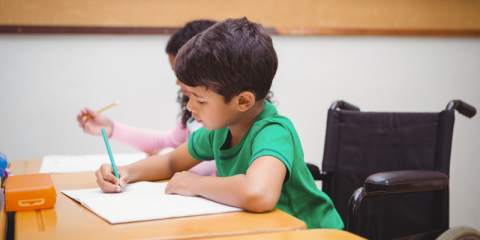
GCED Basic Search Form
Quick Search
Вы здесь
Новости

Persons with disabilities are said to be the world’s largest minority, with generally poor health conditions, low education achievements, few economic opportunities and high rates of poverty. This is largely due to the lack of services available to them.
With the pledge to leave no one behind in the Agenda 2030 for Sustainable Development, this year’s theme on International Day of Persons with Disabilities on 3 December focuses on empowering persons with disabilities as both beneficiaries and change agents for inclusive, equitable and sustainable development.
The term ‘disability’ refers to physical, sensory, cognitive and/or intellectual impairment, and also to mental illnesses and various types of chronic disease. The current reality is that children with disabilities tend not to attend school. As the UNESCO Institute for Statistics showed back in March 2018, in Cambodia 57% of children with disabilities were out school. Conversely, the population aged 15-29 with disabilities who had attended school at all showed the lowest attendance rates of 44% in Viet Nam 2009 and 53% in Indonesia.
We know that learners with disabilities require specialized education. But are we considering whether school facilities are adequate enough to accommodate these learners?
The Education 2030 Agenda and Sustainable Development Goal 4 have formulated Target 4.a on building and upgrading education facilities that are, among other criteria, disability-sensitive to provide inclusive and effective learning environments – for all. To track this target with regards to disability, the proportion of schools with adapted infrastructure and materials for students with disabilities must be monitored.
However, currently available data allows for little interpretation as Member States have yet to collect and submit relevant metrics on adapted infrastructure, in this case for disability. Despite the limited data for the few countries shown in the below figure, they are indicative of the missing infrastructure that would allow children, adolescents and youth with disabilities to attend school.
When everyday necessities, even simply going to the washroom, are an impossibility because doorways are impassible, or the road to school cannot be navigated, in addition to the lack of disability-friendly learning materials, let alone assistive technologies, is it surprising that even those who have attended school at some point often do not continue to attend?
Target 4.a addresses creating and maintaining welcoming and safe learning spaces for learners with disabilities. It does not pretend to be the entire solution for ensuring disability-inclusive education; we know that children with special needs require specialized education, which in turn requires specialized teacher training, as well as holistically designed policies and plans that ensure a legal and regulatory environment to access education.
What is more, we should not forget that ensuring learners are able to access such spaces is another precondition for them to participate. That could mean encouraging parents to have their children attend school, abolishing discriminatory practices in teaching and admissions, and ensuring public transport infrastructure is available to help access schools in the first place.
URL:
https://bangkok.unesco.org/content/honouring-sdg4a-pledge-empowering-learners-disabilities
